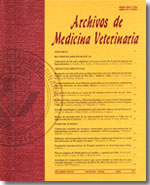Blood biochemical values of loadcart draught horses in the city of Valdivia (Chile)
Main Article Content
Abstract
This study was carried out in order to establish glucose, lactic acid, b-hidroxibutirate (b-HBA), urea, creatininkinase (CK), aspartate aminotransferase (AST), calcium (Ca), inorganic phosphorus (Pi) and magnesium (Mg) blood concentrations in loadcart draught horses in Valdivia, Chile, and the degree of adaptation of these animals to the exercise performed. Also, the relationship of these concentrations with the sex, age and parasite egg counts of the horses were determined.
Sixty serum and plasma samples obtained from clinically healthy, 3 to 20 years old, crossbred geldings and non pregnant mares, were used. Before taking samples, the animals were left to rest for at least 30 minutes, and then subjected to a general clinical examination; name and address of the owner, race, sex, age and weight of the horses were recorded. After the examination, two blood samples were obtained by yugular venopuncture, using plain tubes and tubes with NaF.
Blood mean concentrations were 7.31 ± 1.46 mmol/l, for urea; 0.15 ± 0.09 mmol/l, b-HBA; 4.62 ± 0.55 mmol/l, glucose; 2.55 ± 0.92 mmol/l, lactate; 179.74 ± 85.81 U/1, CH; 390.27 ± 148.56 U/1, AST; 2.74 ± 0.17 mmol/l, Ca; 1.03 ± 0.25 mmol/l, Pi and 0.70 ± 0.07 mmol/1 for Mg.
No significant differences (p > 0.05) were found when blood concentrations of the biochemical parameters analyzed were compared according to age, sex and parasite egg counts of the animals.
It was concluded that loadcart draught horses in Valdivia present mean blood concentrations of plasmatic lactic acid, serum b-HBA and serum activity of CK above the ranges of reference established for the species, suggesting that they are not well adapted to the work they perform. Blood concentrations of the different biochemical parameters analyzed showed no significant correlation (p > 0.05) with the sex and age of the horses .

